Generation of Low-noise Millimeter-wave by Using an Electro-optics-modulator-based Optical Frequency Comb
We are trying to generate ultralow-noise microwave and millimeter-waves using an optical frequency standard toward high-accuracy time and frequency synchronization. We have focused on an electro-optics-modulator-based optical frequency comb (EOM comb), which acts as an optical ruler and developed one with 25-GHz mode spacing. The EOM comb is a useful light source for large capacity optical transmission systems and astronomy. On the other hand, the noise increases and the spectral linewidth widens with distance from the frequency comb’s center wavelength.
We exploited this "disadvantage" to demonstrate that an EOM comb can work as a noise booster and a high-sensitivity detector for detecting the magnified noise from microwave and millimeter-wave signal generators [1]. Our method can generate low-noise and continuously frequency-variable microwave and millimeter-wave signals. In addition, we can overcome the disadvantage of the EOM comb. The interference signal between an optical frequency comb and reference laser with narrow linewidth (i.e. low noise) includes information about the noise from microwave and millimeter-wave signal generators. The noise information is converted into an electrical signal and detected with high sensitivity. Finally, by using the electrical signal, the noise from microwave and millimeter-wave signal generators is reduced with a feedback circuit [Fig. 1(a)]. The further the wavelength is away from the center wavelength of the semiconductor laser, the wider the spectral linewidth becomes. The noise in 25-GHz millimeter-wave signals can be reduced to –110 dBc/Hz at a 1-kHz offset frequency from the center frequency [Fig. 1(b)]. The noise with our method is one-hundred times lower than the lowest noise reported for commercially available signal generators. Even lower noise will be achieved if we use a reference laser that is further away from the center wavelength of the semiconductor laser. In addition, the output frequency of microwave and millimeter-wave signal generators can be expanded for their universal use. We succeeded in generating low-noise signals at continuously variable frequencies over the range from 6 to 72 GHz.
- [1] A. Ishizawa et al., Sci. Rep. 6, 24621 (2016).

|
|
|
Fig. 1. (a) Diagram showing how the noise of microwave and millimeter-wave signal generators is reduced. (b) Experimental noise reduction results for 25-GHz signal. |